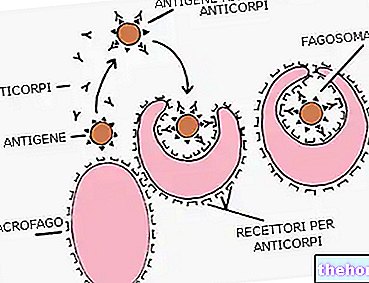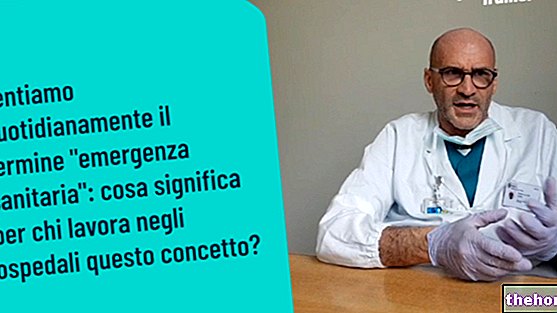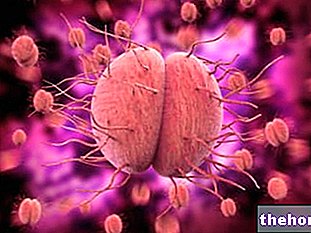TRANSDUCTION: gene transfer mediated by a lambda bacteriophage virus, visible only under the electron microscope.
1st stage) The bacteriophage fimbriae bind to the bacterium wall, thanks to antireceptors that recognize specific adhesion sites on the cell wall.
2nd step) The plate adheres to the bacterium wall. An enzyme is released, called lysozyme, which damages the peptidoglycan which constitutes the bacterial wall.
3rd stage) The tail contracts and the virus DNA is pushed inside the bacterial DNA.

At this point the viral DNA can follow two paths, a first called lytic cycle and a second called lysogenic cycle.
LITHIC CYCLE: DNA replicates, RNA and viral proteins are synthesized; the latter join together (assemble) to form new viruses, in whose head the newly formed viral genome is inserted. Each virus infected bacterium thus turns into a factory of new viral units. At the end of the process, the bacterium undergoes lysis and the release of viruses, which then infect other bacteria.
LYSOGENIC CYCLE: when the virus infects the bacterium, its DNA integrates into the bacterial DNA.
Phages that have a lysogenic cycle are called temperate viruses, because their DNA integrates into the bacterial chromosome and how it behaves; consequently, it is passed on to the new generations without causing any damage to the bacterium. However, this state of quiescence can be broken by suitable stimuli (UV rays, stress, etc.); in these situations the viral DNA can detach (excide), passing from the lysogenic to the lytic cycle.

The lambda phage, which can give both lytic and lysogenic cycles, gives rise to two types of transduction; a generalized call, which occurs following a lytic cycle, and a second one, called specialized, which manifests itself in the passage from the lysogenic to the lytic cycle.
GENERALIZED TRANSDUCTIONBacterial DNA fragments may be incorporated into the virus head during the lytic cycle. A mixed population is formed with phages containing the viral genes of origin, and phages with bacterial DNA; the latter can then inoculate the bacterial genes into a new bacterium, thus, the inoculated DNA merges with the bacterial one. This type of transduction is defined as generalized because any gene from the donor bacterium can be transferred to the recipient bacterium.
SPECIALIZED TRANSDUCTION: the viral DNA integrated in the lysogenic cycle is called PROVIRUS. When we pass from the lysogenic cycle to the lytic cycle, this fragment of donor DNA breaks. Sometimes (rare event) the detachment does not take place in the same sites where it is welded, but in slightly staggered areas; this fragment, therefore, will have lost a portion of viral DNA and acquired some sequences of bacterial DNA. In this way new viruses are formed which carry hybrid DNA in the head and which, infecting new bacteria, transfer certain and specific bacterial genes (from which it specializes).
There is a mechanism called lysogenic conversion, where viral DNA integrated into bacterial DNA (which tends to be silent) can expose certain proteins, which are typically toxins. Bacterial toxins exist in nature due to the expression of viral genes.
TRANSPOSITION: both the bacterial chromosome and the plasmids contain elements called transposable, which are able to move (translocation) from one region of the genome to another, or from the plasmid to the genome, or from one plasmid to the other inside of the same bacterial cell. Generally, when a transposable element moves, a certain sequence remains both in the site of origin and in the one where it was removed. There are different types of transposable elements:
- insertion sequences: they contain a gene that codes for an enzyme that promotes transposition (transpotase).
-transposons: more complex than the previous ones, at the two ends 3 "and 5" contain two IS sequences (insertion) and inside genes for antibiotic resistance (tetracycline, penicillin, chloramphenicol ...)
- invertible elements: they are similar to transposons but retain the ability to invert transposons.
Multi-resistance to antibiotics: mechanisms that frequently occur in hospitals and in the intestine. A bacterium, through conjugation, transmits resistance to a bacterium, already resistant to another antibiotic, on a double plasmid. The new bacterium with double resistance undergoes transposition, ie the double resistance integrates within the same plasmid and transmits the characteristic to other bacteria.
Other articles on "Bacteria: lytic cycle and lysogenic cycle"
- Bacteria: transfer of genetic information
- bacteria
- characteristic bacteria
- bacterial cell
- bacteria accessory structures
- bacterial toxins
- Antibiotics
- Categories of antibiotics
- Antibiotic resistance



























